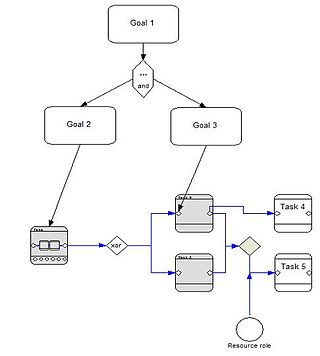
Interoperability is a characteristic of a product or system to work with other products or systems. While the term was initially defined for information technology or systems engineering services to allow for information exchange, a broader definition takes into account social, political, and organizational factors that impact system-to-system performance.
The Organization for the Advancement of Structured Information Standards is a nonprofit consortium that works on the development, convergence, and adoption of projects - both open standards and open source - for Computer security, blockchain, Internet of things (IoT), emergency management, cloud computing, legal data exchange, energy, content technologies, and other areas.
An open standard is a standard that is openly accessible and usable by anyone. It is also a common prerequisite that open standards use an open license that provides for extensibility. Typically, anybody can participate in their development due to their inherently open nature. There is no single definition, and interpretations vary with usage. Examples of open standards include the GSM, 4G, and 5G standards that allow most modern mobile phones to work world-wide.

Timothy Richard Goebel is an American former competitive figure skater. He is the 2002 Olympic bronze medalist. He was the first person to land a quadruple salchow jump in competition and the first person to land three quadruple jumps in one program. He landed 76 career quadruple jumps before his retirement in 2006.
The Network Processing Forum (NPF) is an industry forum that was organized to facilitate and accelerate the development of next-generation networking and telecommunications products based on network processing technologies. The NPF was merged into the Optical Internetworking Forum in June 2006. The NPF produces Hardware, Software, and Benchmark Interoperability Agreements. These agreements enable equipment manufacturers to lower their time to market and development cost by enabling a robust, multi-vendor ecosystem. It also lowers the total cost of ownership of systems based on their interoperability agreements by enabling investments in test and verification infrastructure as well as enabling competition.

Enterprise integration is a technical field of enterprise architecture, which is focused on the study of topics such as system interconnection, electronic data interchange, product data exchange and distributed computing environments.

Extended Enterprise Modeling Language (EEML) in software engineering is a modelling language used for Enterprise modelling across a number of layers.
Web3D Consortium is an international not-for-profit, member-funded industry consortium, originally founded in 1997. Web3D Consortium members from governmental, nonprofit and research organizations worldwide, including working alongside individual professional members to collaborate in a consensus process and encouraging development and implementation of open standards for 3D content and services.
Simple Knowledge Organization System (SKOS) is a W3C recommendation designed for representation of thesauri, classification schemes, taxonomies, subject-heading systems, or any other type of structured controlled vocabulary. SKOS is part of the Semantic Web family of standards built upon RDF and RDFS, and its main objective is to enable easy publication and use of such vocabularies as linked data.
Semantic interoperability is the ability of computer systems to exchange data with unambiguous, shared meaning. Semantic interoperability is a requirement to enable machine computable logic, inferencing, knowledge discovery, and data federation between information systems.
Network Centric Product Support (NCPS) is an early application of an Internet of Things (IoT) computer architecture developed to leverage new information technologies and global networks to assist in managing maintenance, support and supply chain of complex products made up of one or more complex systems, such as in a mobile aircraft fleet or fixed location assets such as in building systems. This is accomplished by establishing digital threads connecting the physical deployed subsystem with its design Digital Twins virtual model by embedding intelligence through networked micro-web servers that also function as a computer workstation within each subsystem component (i.e. Engine control unit on an aircraft) or other controller and enabling 2-way communications using existing Internet technologies and communications networks - thus allowing for the extension of a product lifecycle management (PLM) system into a mobile, deployed product at the subsystem level in real time. NCPS can be considered to be the support flip side of Network-centric warfare, as this approach goes beyond traditional logistics and aftermarket support functions by taking a complex adaptive system management approach and integrating field maintenance and logistics in a unified factory and field environment. Its evolution began out of insights gained by CDR Dave Loda (USNR) from Network Centric Warfare-based fleet battle experimentation at the US Naval Warfare Development Command (NWDC) in the late 1990s, who later lead commercial research efforts of NCPS in aviation at United Technologies Corporation. Interaction with the MIT Auto-ID Labs, EPCglobal, the Air Transport Association of America ATA Spec 100/iSpec 2200 and other consortium pioneering the emerging machine to machine Internet of Things (IoT) architecture contributed to the evolution of NCPS.
NEARnet was an innovative high-speed regional network for education, research and development, established in 1988 by a consortium led by Boston University, Harvard University, and MIT. It was a precursor to the commercial internet, formed after DARPA announced plans to dismantle the ARPANET. ARPANET then accounted for 71 of the consortium's 258 host connections.
The virtual world framework (VWF) is a means to connect robust 3D, immersive, entities with other entities, virtual worlds, content and users via web browsers. It provides the ability for client-server programs to be delivered in a lightweight manner via web browsers, and provides synchronization for multiple users to interact with common objects and environments. For example, using VWF, a developer can take video lesson plans, component objects and avatars and successfully insert them into an existing virtual or created landscape, interacting with the native objects and users via a VWF interface.

Image files that contain verifiable information about learning achievements, Open Badges are based on a group of specifications and open technical standards originally developed by the Mozilla Foundation with funding from the MacArthur Foundation. The Open Badges standard describes a method for packaging information about accomplishments, embedding it into portable image files as a digital badge, and establishing an infrastructure for badge validation. The standard was originally maintained by the Badge Alliance Standard Working Group, but transitioned officially to the IMS Global Learning Consortium as of January 1, 2017.

Sanjiv Rai is a first-generation Indian innovator and serial entrepreneur. He is the Founder, Chairperson and Chief Solver of multiple startups under Billion Innovators and Chairperson at ARE Technologies and his venture initiatives AceWP Innovation Labs and BillionInnovators intend to promote innovation in India and abroad. As a serial Entrepreneur or Innovator he has worked on AI based convergence and design algorithms, on a variety of products and solutions such as network convergence enabling D5 chip, AceWP, PlasmaPHI, innovate2learn, agniie devices, ChazeMe, SmartSAPS(Smart Secured Automated Payment Solutions), coolATM and Rosenbridges Future Cities/Smart Buildings and CHANDRA project for NASA towards permanent human inhabitancy on outer planets.
The Risk & Compliance Portal is a powerhouse for business anti-corruption information offering tools on how to alleviate or reduce risks and costs of corruption when doing business abroad. All the information on the Portal is produced by GAN Integrity Solutions, a Denmark-based IT & Professional Services firm. The Portal was created in 2006 and is aided by the European Commission and a number of European governments.
Cross-domain interoperability exists when organizations or systems from different domains interact in information exchange, services, and/or goods to achieve their own or common goals. Interoperability is the method of systems working together (inter-operate). A domain in this instance is a community with its related infrastructure, bound by common purpose and interests, with consistent mutual interactions or rules of engagement that is separable from other communities by social, technical, linguistic, professional, legal or sovereignty related boundaries. The capability of cross-domain interoperability is becoming increasingly important as business and government operations become more global and interdependent. Cross-domain interoperability enables synergy, extends product utility and enables users to be more effective and successful within their own domains and the combined effort.

Federated Mission Networking (FMN) is a significant initiative to help ensure the interoperability and operational effectiveness of the North Atlantic Treaty Organization. It is a key contribution to the Connected Forces Initiative, helping Allied and Partner forces to better communicate, train, and operate together. This includes the NATO Command Structure as well as the NATO Force Structure. The purpose of FMN is ultimately to support Command, Control, Communications, Computers, Intelligence, Surveillance and Reconnaissance (C4ISR) and decision-making in operations by enabling the rapid instantiation of mission networks. Including the NATO Command Structure, 39 nations have joined the FMN initiative as so-called "FMN Affiliates" and work together under the FMN Framework Process to coordinate the design, development, and delivery of operational and technical capabilities required to conduct net-centric operations. Each development increment is referred to as an "FMN Spiral.". The respective requirements, architecture, standards, procedures, and technical instructions are documented in the so-called "FMN Spiral Specifications.". FMN Spiral Specifications are based on well-known standards and best practices, hence supported by most off-the-shelf products and vendor neutral. TACOMS standards and profiles specify a common, technology- and topology independent network interoperability layer for federated mission networks. There is also a rolling 10-year FMN Spiral Specification Roadmap of the envisioned future capabilities. At the same time, the Coalition Interoperability Assurance and Validation (CIAV) process ensures that current interoperability issues are being identified and fed back into FMN capability development.







